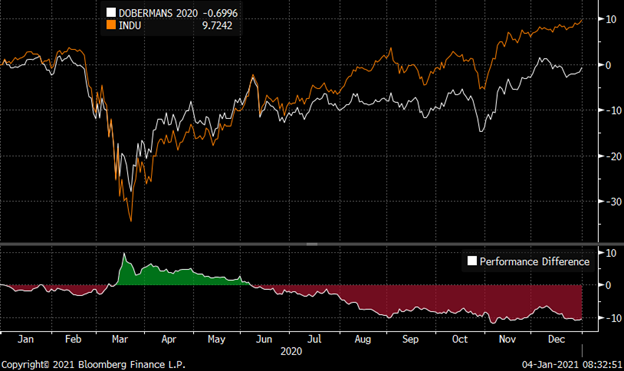In 2021, The Best Dogs In The Dow Are Dobermans
Submitted by Silverlight Asset Management, LLC on January 5th, 2021
Three years ago, I introduced Forbes readers to a stock strategy called the Dobermans of the Dow. This is my annual strategy update.
The Dobermans of the Dow is a simple stock screening system with two steps:
1) Rank Dow constituents by Return on Equity (ROE), keep the top 20.
2) Rank remaining names by Free Cash Flow Yield, keep the top ten.
Those final ten stocks are your Dobermans.
Based on the selection criteria, the list favors firms with above-average profitability whose shares trade at relatively cheap prices. The goal is to refresh the lineup about once a year, which for our purposes is every December 31st.
Now, let’s review performance. Here is how the Dobermans performed in one of the craziest stock market years ever.
Source: Bloomberg
The following table shows how the Dobermans have performed on a relative basis since 2018.
2020 Performance
The first quarter of the year was typified by one of the most dramatic selloffs in Wall Street history. From 2/12/2020 through 3/23/2020, the Dow fell -37.1% while the Dobermans declined -27.9%. After outperforming during the selloff phase, the Dobermans subsequently lagged the Dow during the rebound before finishing the year roughly flat.

The most significant detractor from relative performance in 2020 was not owning Apple. After surging 82% in 2020, the iPhone-maker was responsible for 5.8% of the Dow’s 9.7% total return. In other words, Apple alone drove about 60% of the overall gain in the Dow.
It is fairly normal for only a handful of stocks to drive the bulk of a portfolio’s return in a given year. What is more odd about Apple’s situation is how dramatically the stock has outpaced fundamentals. Over the last two years, the Cupertino-based company has averaged revenue growth of just +1.7% and operating income growth of -3.1%, yet the shares have appreciated at a whopping rate of 86.3% per year (247% cumulatively).
What’s so exciting about flat growth? Perhaps investors are giddy with enthusiasm over future developments. Whatever the case, the Dobermans are selected based on how trailing fundamental data matches up to current prices, which explains why the screen no longer favors Apple.
Taking a step back, obviously no one enjoys underperforming the market, even if it’s inevitable with any strategy. When it happens, it’s important to get curious about causality. I always focus on two questions:
(i) Why did the strategy underperform?
(ii) Am I comfortable with those reasons?
Thanks to the factor research staff at Bloomberg, we can deconstruct performance rather easily using a prism of style factors.
The two main ‘factors’ in the Dobermans screen are Profitability (ROE) and Value (Free Cash Flow Yield).
If we survey how those two style factors performed in 2020, we can see they were bottom of the barrel. Outside of Apple, this explains most of what we need to know about why the Dobermans lagged. Basically, it wasn’t their season.
Even if the majority of investors preferred volatile stocks (+12.5%) and growth stocks (+7.3%) in 2020, I am personally comfortable sticking with profitable companies (i.e. high ROE) that trade at relatively cheap prices (i.e. high free cash flow yield). Not only have these factors outperformed historically, but it also makes logical sense to me why profitability and value are attractive traits to have in a portfolio over time.
It’s kind of like... why settle for a Poodle if you can own a Doberman instead?

From a factor perspective, high volatility and weak profitability tend to outperform at the beginning of new bull markets, during a phase some traders call a “junk rally.”
Put simply, this is a time when companies with the worst fundamentals may briefly outperform, because everyone is so relieved they didn’t just go out of business.
Over the long-term, though, companies with the best fundamentals deliver the best returns. And like we saw in March, fundamental factors such as Value and Profitability matter quite a lot during market dislocations. This is an important observation for investors who target high risk-adjusted returns.
Commonly Asked Questions
Since I started writing about the Dobermans of the Dow, I have received many emails with variations of the same questions. So, I thought I would answer some of the most common ones here.
Question: Have you ever thought about tweaking the factors a little more this way... <fill in the blank>?
Answer: I have studied many stock selection factors throughout my career. That said, I will probably not change the Dobermans of the Dow screen anytime soon.
When it comes to quantitative finance, I am always weary of over-optimizing. It can become a slippery slope where the more you do it, the easier it gets to data mine, and the harder it gets to maintain a semblance of common sense about what you are trying to achieve.
If something is simple and it works, that’s good enough for me. The Dobermans of the Dow strategy is simple. And so far, it works.
Source: Bloomberg
Question: What if we rebalance more frequently?
Answer: There might be merit in rebalancing the Dobermans more than once a year, particularly in tax-deferred accounts like an IRA.
Here is a backtest comparison of average annual returns using three different rebalancing frequencies (annual, semi-annual, quarterly) from 12/31/1997 through 12/31/2020 (source: Bloomberg):
- Annual: + 13.8%
- Semi-annual: +14.6%
- Quarterly: +15.1%
Question: What if we combine the Dobermans with other trading signals or timing strategies?
Answer: Investors may be able to improve performance by blending an effective timing overlay.
At my firm, we run an actively-managed version of the Dobermans strategy using a variety of technical tools, including Demark Indicators. In our case, we like to create a ratio of the single securities relative to a broader universe. I prefer to use the S&P 500 instead of the Dow, mainly because the sample size for cross-comparison is larger. Then, we can overlay indicators like TD Combo to evaluate when a relative pair is becoming stretched in either direction.
For example, the chart below shows a TD Combo overlay on a weekly JNJ/SPY ratio. Magenta 13s indicate areas where the existing trend was ripe for exhaustion, and you can see how well the 13s correspond to relative performance reversals.

Source: DeMark Analytics, Bloomberg.
Exhaustion indicators like this can be particularly effective with large-cap Dow stocks, because they are usually mature companies with a more well-defined ‘fair value zone’ compared to the average stock. This makes them above-average mean reversion trades when they become relatively oversold or overbought.
Of course, not everyone has access to the same indicators or technology. If you don’t have DeMark Indicators or a worthy substitute available to you, it’s probably wise to avoid adding extra layers of complexity. Thankfully, you can probably do just fine following a simple program of annual rebalancing.
2021 Dobermans
Finally, let’s meet the 2021 Dobermans of the Dow. Good luck in the new year!
Originally published by Forbes. Reprinted with permission.
Disclosure: I own shares of AMGN, CAT, CSCO, IBM, INTC, JPM, MMM, UNH, VZ and WMT in accounts that I professionally manage. This material is not intended to be relied upon as a forecast, research or investment advice. The opinions expressed are as of the date indicated and may change as subsequent conditions vary. The information and opinions contained in this post are derived from proprietary and nonproprietary sources deemed by Silverlight Asset Management LLC to be reliable, are not necessarily all-inclusive and are not guaranteed as to accuracy. As such, no warranty of accuracy or reliability is given and no responsibility arising in any other way for errors and omissions (including responsibility to any person by reason of negligence) is accepted by Silverlight Asset Management LLC, its officers, employees or agents. This post may contain “forward-looking” information that is not purely historical in nature. Such information may include, among other things, projections and forecasts. There is no guarantee that any of these views will come to pass. Reliance upon information in this post is at the sole discretion of the reader.

